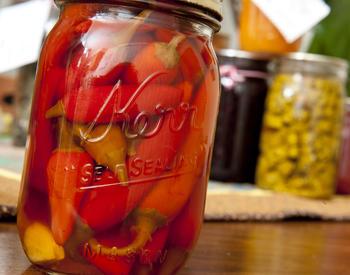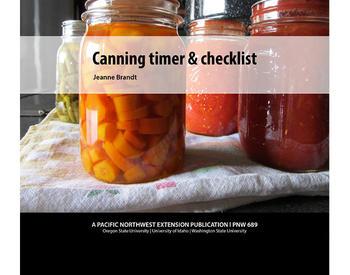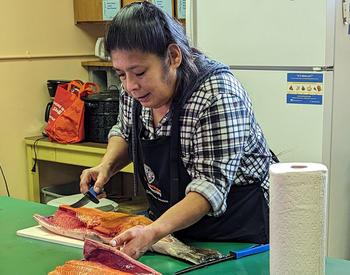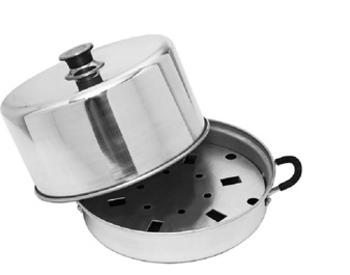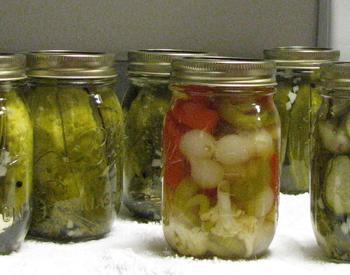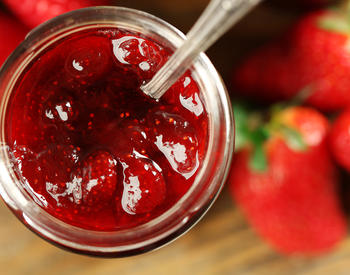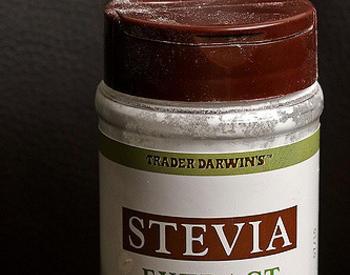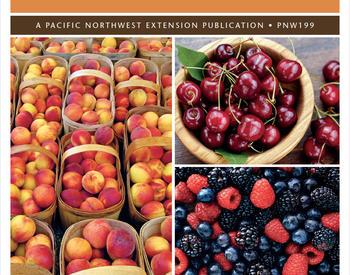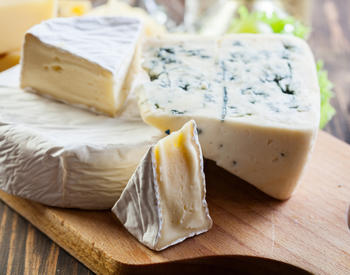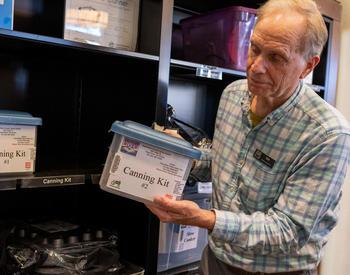Download this publication as a PDF
Nutritive sweeteners
Agave
Barley malt syrup
Beet sugar
Brown rice syrup
Chicory
Coconut sugar
Produced from the sap of the flowers of the coconut palm, this sugar is similar in look and taste to brown sugar with a hint of caramel. It is made mostly of sucrose with small amounts of glucose and fructose. It has a low glycemic index of 35 and can be substituted 1:1 for sugar in most recipes. It is high in zinc, iron, potassium and magnesium in addition to several B vitamins. It is considered a good choice for diabetics. One tsp = 15 cal.
Corn syrup
This syrup is made from the starch of corn and is usually 100% glucose. Not as sweet as sucrose, one of its major uses is in commercially prepared foods as a thickener. It has moisture-retaining properties and also helps to maintain freshness and inhibit crystallization in cooking and making freezer jam. One tsp = 20 cal.
Date sugar
Ground dates are a natural, whole food sweetener. They contain concentrated sweetness plus antioxidants and fiber. This sugar may not dissolve completely in recipes so it works well for coarse foods like artisan breads, cookies or granola bars.
Fructose
Also known as levulose and fruit sugar, it is found in fruits, honey and root vegetables. Fructose from foods results in minimal rises in blood sugars and is the optimal way to consume fructose. But commercially produced fructose is derived from cane sugar, sugar beets and maize. It makes up about half the sugar in sucrose or high fructose corn syrup. See high fructose corn syrup below. One tsp = 15 cal.
Galactose
Found in milk and other dairy products, galactose is about 65% as sweet as sucrose. When paired with glucose, galactose forms the sugar, lactose.
Glucose
The primary source of fuel for the body, it is the only sugar used by brain cells. For this reason, the body converts other sugars and carbohydrates to glucose. It is found in nearly all plant foods including algae. Glucose makes up half the sugar in sucrose and high fructose corn syrup. It is also known as dextrose and blood sugar. One tsp = 16 cal.
High fructose corn syrup
High fructose corn syrup, sometimes also called glucose-fructose syrup, is a mixture of water with glucose (45%) and fructose (55%) produced from corn. Since it is sweeter and more soluble than other sugars and inexpensive to produce, it is added to many commercial products including soft drinks, fruit drinks, breads, lunch meats, soups and condiments.
Excessive consumption of high fructose corn syrup is associated with insulin resistance, high cholesterol and metabolic syndrome. It is not recommended for diabetics or those with active heart disease. One tsp = 18 cal.
Invert and divert sugars
Invert sugar is equal parts of glucose and fructose found naturally in fruits and honey and produced artificially for the food industry. It is an “inversion” of sucrose achieved by treating it with acids. Invert sugar tends to be sweeter than sucrose and retains moisture, favored by bakers.
Divert sugar is a superfine sugar, with no corn starch added, similar to confectioners’. It contains 8% invert sugar and holds moisture without grittiness and works well for frostings, fondants and candy centers.
Honey
Honey is the mixture of sugars formed from nectar by an enzyme, invertase, found in the body of bees. It is composed of fructose and glucose, the same two sugars as in sucrose, and therefore has the same sweetness as granulated sugar but with a lower glycemic index (55 compared to sugar’s 65). Honey is supersaturated and contains more sugar than can normally be dissolved in water.
Sometimes dormant endospores of Clostridium botulinum are contained in honey, which can make it dangerous, even deadly, to infants. Honey inhibits fermentation, but if exposed to moist air, it can still begin to ferment. Store in tightly sealed glass containers. One tsp = 21 cal.
Lactose
Known as milk sugar, this is derived from galactose and glucose. Since it is less sweet and soluble than other sugars, it is rarely added directly to foods. Exceptions would include commercial baby formulas, baked products and stout beer. Some people lose the ability to digest lactose and become lactose intolerant. This sweetener is not recommended for infants less than 1 year of age.
Maltose
Composed of two glucose molecules, maltose is sometimes referred to as malt sugar. It is found in molasses and is used in fermentation. It can be found in beverages, mostly beer, and in foods like cereal, pasta, potatoes and many processed products.
Maple syrup
This syrup is made from the sap of maple trees, which store the starch in their trunks and roots before winter, then convert it to a sugar sap in the spring. Holes are bored into tree trunks to extract the sap and it is heated to evaporate the water. Syrups are graded as A or B with Grade B having a darker color and richer flavor. Maple sugar is two times sweeter than table sugar and has 15 times more calcium than honey. One tsp = 17 cal.
Note: “Maple-flavored syrup” does not contain the healthy potassium, zinc and amino acids since this is made from corn syrup with added maple flavorings.
Molasses
A thick, viscous product derived from the third boiling of cane syrup, blackstrap molasses contains 20% of the daily value for calcium, magnesium, potassium and iron, and is known for its robust flavor. It is the principal ingredient of rum and stout or porter beers and in the production of citric acid. It is often used as a darkening agent or colorizer in refined enriched grains. Molasses can also be made from sugar beets. One tsp = 15 cal.
Muscovado sugar
This is an unrefined sugar made from sugar cane that looks like brown crystals, similar to brown sugar, but much darker brown since it is higher in molasses. It retains many minerals including calcium, magnesium, potassium and iron. It is also called Barbados sugar or “moist sugar” and may make some recipes too wet. Barbados natives use it as a sweetener for coffee or beverages. One tsp = 11 cal.
Raw sugar
Also known as turbinado sugar, this cane-sugar product is similar in appearance to brown sugar but paler and with a higher moisture content, making it useful for baked goods. It is raw since it has undergone minimal refining other than to remove impurities. Some believe it is a healthier alternative to table sugar since it is less refined. The nutritional components, however, are equivalent. One tsp = 17 cal.
Sucanant
This is a less-processed version of cane sugar, which also retains a molasses flavor. It is a good substitute for brown sugar.
Sugar (sucrose)
Sucrose is made of equal parts of glucose and fructose and is known as table sugar. It is found naturally in fruits and vegetables, but mostly derived from sugar cane (80%) or sugar beets (20%). It is dissolved and purified using phosphoric acid and dried to prevent clumping.
It comes in many forms including coarse, granulated, superfine, powdered and brown. It is used as a sweetener in baked products and is important to the structure of many foods including biscuits and cookies, candy, ice cream and sorbet. It is a key component in the browning of baked goods and the preservation of foods. One 12-ounce regular soft drink contains 9–12 teaspoons of sugar. One tsp = 17 cal.
Sugar alcohols
Sorbitol, Mannitol, Xylitol, Isomalt, Lactitol, Maltitol, Erythritol (also see Truvia under Stevia)
Also called polyols, sugar alcohols are carbohydrates that occur naturally in some fruits and vegetables, but can also be manufactured. Often labeled as “sugar-free” or “reduced-sugar.” They are neither sugars nor alcohols but are incompletely absorbed by the body and therefore contribute fewer calories than sugars. They are often used in products for weight control. Besides sweetness, they can add bulk and texture and are often used as thickeners as well as sweeteners.
Most sugar alcohols are less sweet than table sugar, and are often used in combination with highly sweet artificial sweeteners. The combination provides a sweet product with lower calories. Since sugar alcohols produce a lower glycemic response, they may be useful for those with diabetes. They also do not contribute to tooth decay.
Sugar alcohols are generally not used in home food preparation but are found in processed foods and other products like chocolate, candy, frozen desserts, chewing gum, toothpaste and baked goods. They do not brown or caramelize when heated. Sugar alcohols like xylitol and sorbitol can add a “cooling” sensation to products like toothpaste and chewing gum.
These sweeteners should be used in moderation since they may cause diarrhea, gas or bloating in larger doses. One tsp ranges from 0 to 4 cal.
Non-nutritive sweeteners
These provide zero or very low calories since the molecules are large and are partially indigestible. Most are sweeter than sugar so you can use less.
The FDA has approved the use of these seven non-nutritive sweeteners below.
AcesulfameK (Ace-K)
Brand names: Sweet One®and Sunett®
The “K” in this sweetener represents potassium. It is 200 times sweeter than sucrose and about one-third as sweet as sucralose. It tends to have a slight aftertaste and is often combined with other sugars to reduce the bitterness. It is heat stable and can be used in cooking and baking, even under acidic conditions used in food preservation.
It is often used in commercial products to extend shelf life including products like carbonated drinks, protein shakes, and chewable or liquid medications. Since it does not contribute to blood sugars, it is acceptable for diabetic diets. For recipes and more information, go to www.sweetone.com.
Advantame
Approved for use as a sweetener and flavor enhancer (except in meat and poultry), it is approximately 20,000 times sweeter than table sugar. It is heat stable and can be used in baking or cooking at high temperatures. As one of the newest sweeteners on the market, it is not yet commonly used in commercial products.
Aspartame
Brand names are Equal®, Nutrasweet®, Sugar Twin®
This sweetener consists of two amino acids, aspartic acid and phenylalanine. It does contain calories, which qualifies it as a nutritive sweetener. But since it is 200 times sweeter than sugar, consumers can use a small amount to provide the same sweetness. It is often found in beverages, dairy products, canned fruits, desserts, confections, sauces and salad dressings.
Aspartame breaks down if heated so it is not a good choice for baking or preserving but can be added to foods after being cooked and cooled. It does not contribute to dental decay and can be used by diabetics. It is not for use by those with the hereditary disease PKU who cannot metabolize phenylalanine.
Because it contains phenylalanine, those with the disease PKU (Phenylketonuria) should not consume Aspartame. One tsp = 2 cal. (Each packet of Equal contains the equivalent of 2 tsp). For recipes and more information, go to www.equal.com.
Luo Han Guo Fruit Extract (Monk Fruit)
Brand names: Nectresse®, MonkFruit in the Raw®, PureLo®
This sweet extract from the Siraitia grosvenorii swingle fruit is sometimes called SGFE or monk fruit, and is native to southern China. Depending on the fruit, it can be 100–250 times sweeter than sugar. It is accepted by the FDA as generally recognized as safe.
Neotame
Manufactured by the Nutrasweet company, but labeled as Newtame®
Composed of the same ingredients as Aspartame but with a structural difference, it is 40 times sweeter than Aspartame and 7,000–13,000 times sweeter than table sugar. It is heat stable and does not contribute to blood sugars. It is approved as a flavor-enhancer in foods except meat and poultry. It can be found in frozen desserts, gum, candy, baked goods and beverages. For recipes and information on neotame, go to www.neotame.com.
Saccharin
Brand names: Sweet’N Low®, Sweet and Low®, Sweet Twin®, Necta Sweet®
Discovered more than 100 years ago, this is the oldest of the artificial sweeteners and has limited FDA approval for use in beverages and tabletop products. It also has strict stipulations for maximum allowable amounts. It has no calories and ranges in sweetness from 200 to 700 times sweeter than sugar depending on the form (calcium saccharin or acid saccharin). For recipes and information, go to the Sweet 'N Low website.
Note: Although saccharin was removed from the list of carcinogens in 2000, it is not recommended for pregnant or lactating women.
Sucralose
Brand name Splenda®
This product begins as sucrose. Three hydrogen atoms are replaced with chlorine atoms, resulting in a largely indigestible product that yields no calories and is 600 times sweeter than table sugar.
Although sucralose is calorie-free, Splenda has added sugars (dextrose and maltodextrin) that increase calories to 3.36 per gram.
It is used in beverages, baked goods, syrups and desserts designed for weight loss. It is the most heat-stable of all the artificial sweeteners and can be used in cooking and baking without flavor loss. One tsp = 2 cal. (One packet of Splenda contains the equivalent of 2 tsp). For recipes and more information go to www.sucralose.com
Stevia
Also known as Steviol glycoside, using brand names Sweet Leaf®, Only Sweet™, Truvia®, PureVia®, Enliten®
This sweetener is derived from the leaves of the Stevia rebaudiana plant, herbs native to subtropical and tropical regions in western North and South America. It is 300–400 times sweeter than sugar and may have a licorice-like aftertaste. It is often found in diabetic foods since it has zero calories, does not raise blood sugars and may improve glucose tolerance.
The use of stevia leaf and crude stevia extracts are not generally recognized as safe by the FDA. FDA laws limit sale, labeling and usage of stevia leaves and extracts only as a dietary supplement but not as a sweetener.
Stevia leaves (Stevia rebaudiana) have been used as herbs for centuries. The leaves have phytochemicals similar to those of mint and basil with the advantage that the stevia leaves have a sweetness that can be used in foods and drinks. The leaves can have up to 4 times the sweetness of sugar and also contain healthful compounds like tannins and flavonoids, antioxidants that fight disease. However, extracts made from the stevia leaves do not contain these healthful compounds.
To date, there are no long-term studies outlining the safety of this sweetener although it has been used in other countries for many years.
Rebaudioside A, an extract form of stevia, is considered by the FDA as generally recognized as safe.
Note: Truvia® or PureVia® are not equivalent to stevia since they are mainly sugar alcohols derived from corn with a small amount of the stevia extract Rebaudioside A (Reb A) along with additional unidentified natural flavors. Since these products are mostly sugar alcohols, they are approved by the FDA.
Susta™
Considered a natural sweetener, this product contains prebiotics in the form of soluble fiber and probiotics (beneficial bacteria). The combination helps support the immune system. It does contain a small amount of calories.
Swerve
A zero-calorie sugar replacement, this fermented sweetener is made from fruits and starchy vegetables. The process creates the sugar alcohol, erythritol, and oligosaccharides, a type of indigestible fiber. Citrus flavors are added. It is used in baking since it measures cup for cup like sugar. It has 60–89% the sweetness of sugar and less than 1 calorie per gram. Unlike other sweeteners, it browns and caramelizes during cooking.
Sugar alcohols may cause digestive issues.
Zùsto®
This sugar substitute is composed of nondigestible fibers from chicory and rice combined with sugar alcohols and sucralose. It is used in baking and candy-making. It contains one-quarter the calories of sugar and has a lower glycemic index.
This new sweetener, currently used in Europe and Asia, is available online in the U.S. Be advised, there is no data available on its safety.
Natural vs. artificial
Natural sweeteners are sugar substitutes that may appear “healthier” than sugar, like fruit juice, honey, molasses, and maple syrup. Some can be highly processed and refined as in fruit nectars, which are considered less healthful than the whole foods from which they are derived.
Artificial sweeteners are synthetic sugar substitutes, but may also be derived from natural substances like herbs. They are usually many times sweeter than natural sugar.
For more information
For more information, please visit USDA: Nutritive and Non-nutritive Sweetener Resources.
For lists of the names of added sugars found on food labels. visit Added Sugars.
Related articles
References:
- Cleveland Clinic
- Food and Drug Administration
- Food and Nutrition Information Center
- Neotame
- Sweet 'n Low
- Sucralose
- Sweet One
- Swerve
- Zùsto
- Pen, JJ, et al. Zusto: A new sweetening agent with low glycemic index. Clin Nutr ESPEN 2018. Feb:23:103-106.
